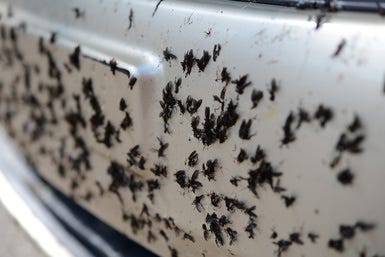
Twice each year Florida love bugs swarm in their meandering way, causing folks to swipe in the air to get them out of their faces, and use extra care in removing their remains from the windshield of their cars. The whole purpose of love bugs are to reproduce, so they say, but where do they come from? Why do we see these insects only twice per year? Most of the country has never heard of this black, vehicle seeking creature, but those of us in the Sunshine State know it happens every May and September. Love bug season. According to Wikipedia, Florida love bugs are not bugs at all. They are considered flies of the order Diptera. The common name of the flying menace is Plecia nearctica, a small fly in the family Bibionidae, also known as March flies. We often see them flying in pairs, male and female connected together mating. The tiny creatures don’t have very long—for the male, just a day or two, the female about ten days—and after the mating flight, the female plots the male’s painful death. According to Florida Department of Agriculture, (FDA), he’s terribly tired after the mating game. So, she takes the lead and drags him along with her, not allowing him to eat or drink, spinning and slamming his tired body into any nearby object. In a day or so the male is dead and she shakes loose his lifeless frame, immediately seeking another mate. FDA reports the female may have five to ten males throughout the season and exhausts herself, only to settle into decaying cut grass or wood, laying 200 to 300 eggs and…dies.
FDA reports that although it is unclear why the love bugs have the May and September cycle, (the short one is May with the longer one in September), only a small portion of the life span is spent in the love bug form, as most of the cycle exists in the larvae stage. They live in the soil as small, worm like creatures. Debbie Hadley, Insect Expert, at the about education website www.insects.about.com, said love bugs larvae are important decomposers of plant material, helping to build soil rich in organic matter.
FDA reports they have no predators other than automobiles, and they do not sting, neither bite nor harm plants or livestock. It seems they’re driven to any area where vehicles will drive through them, causing the front end of the car and windshields to be covered with dead love bugs. Hadley said it’s important to remember when the carcasses of the love bugs bake in the sun, their body fluids become acidic and damage the car’s paint.
This article originally appeared on Santa Rosa Press Gazette: Love bugs season is almost amongst us
